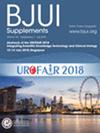Clinical utility of tumour‐informed circulating tumour DNA in patients with testicular cancer
IF 4.4
2区 医学
Q1 UROLOGY & NEPHROLOGY
引用次数: 0
Abstract
ObjectivesTo investigate whether circulating tumour DNA (ctDNA) predicts oncological outcomes in the minimal residual disease (MRD) window after radical orchiectomy or retroperitoneal lymph node dissection (RPLND), and to evaluate the diagnostic performance of ctDNA in reference to imaging studies in clinical stage (CS) I disease.MethodsLongitudinal tumour‐informed ctDNA assays (Signatera™) were collected prospectively from consecutive patients during 2022–2023. The ctDNA signature was informed from the orchiectomy or RPLND specimen. The MRD window was defined as the initial 90 days after orchiectomy or RPLND. Event‐free survival (EFS) and recurrence‐free survival (RFS) were assessed using the Kaplan–Meier method.ResultsSixty patients with a median (interquartile range) follow‐up of 18 (13–23) months underwent 287 ctDNA analyses; 45% had seminoma. At initial staging, 65% had CS (clinical stage) I, 20% CS II, 3.3% CS III, and 10% CS IS. Post‐orchiectomy ctDNA clearance was achieved in 80% of patients, and patients with undetectable MRD ctDNA had superior 3‐month (100% vs 25% [95% confidence interval [CI] 7.5–83]) and 12‐month EFS (91% [95% CI 79–100] vs (13% [95% CI 2–78]) compared to detectable ctDNA, respectively. Undetectable MRD window ctDNA in patients with CS I undergoing surveillance was associated with an 18‐month RFS of 88%. The diagnostic performance of ctDNA compared to imaging studies for CS I per patient was: sensitivity 33.3%, specificity 93.5%, positive predictive value 33.3%, and negative predictive value (NPV) 93.5%. Detectable pre‐RPLND ctDNA fully correlated with tumour presence, while undetectable ctDNA corresponded to benign histology or teratoma on pathology. Undetectable RPLND MRD ctDNA was associated with superior 9‐month RFS vs detectable ctDNA (100% vs 25% [95% CI 5–100], respectively).ConclusionctDNA status in the MRD window predicted survival outcomes after orchiectomy and RPLND. Undetectable MRD window ctDNA demonstrated high NPV relative to imaging studies in CS I disease. Further investigation is warranted.循环肿瘤DNA在睾丸癌患者中的临床应用
目的探讨循环肿瘤DNA (ctDNA)是否能预测根治性睾丸切除术或腹膜后淋巴结清扫(RPLND)后最小残留病(MRD)窗口的肿瘤预后,并结合临床分期(CS) I期疾病的影像学研究评价ctDNA的诊断价值。方法在2022-2023年期间,前瞻性地收集连续患者的纵向肿瘤知情ctDNA检测(Signatera™)。ctDNA特征来自睾丸切除术或RPLND标本。MRD窗口定义为睾丸切除术或RPLND后的最初90天。采用Kaplan-Meier法评估无事件生存期(EFS)和无复发生存期(RFS)。结果60例患者接受了287次ctDNA分析,随访时间为18(13-23)个月;45%为精原细胞瘤。在初始阶段,65%的患者为临床期CS, 20%为临床期CS, 3.3%为临床期CS, 10%为临床期CS。80%的患者在睾丸切除术后实现了ctDNA清除率,MRD ctDNA检测不到的患者在3个月(100% vs 25%[95%置信区间[CI] 7.5-83])和12个月的EFS (91% [95% CI 79-100] vs (13% [95% CI 2-78])分别优于可检测的ctDNA。在接受监测的CS I患者中,无法检测到MRD窗口ctDNA与18个月的RFS为88%相关。与影像学检查相比,ctDNA对每名患者CS I的诊断表现为:敏感性33.3%,特异性93.5%,阳性预测值33.3%,阴性预测值(NPV) 93.5%。可检测到的RPLND前ctDNA与肿瘤存在完全相关,而未检测到的ctDNA在病理上对应于良性组织或畸胎瘤。不可检测的RPLND MRD ctDNA与可检测的ctDNA相比,9个月的RFS更高(100% vs 25% [95% CI 5-100])。结论MRD窗口dna状态预测睾丸切除术和RPLND后的生存结局。与影像学研究相比,无法检测到的MRD窗口ctDNA显示了CS I疾病的高NPV。有必要进一步调查。
本文章由计算机程序翻译,如有差异,请以英文原文为准。
求助全文
约1分钟内获得全文
求助全文
来源期刊

BJU International
医学-泌尿学与肾脏学
CiteScore
9.10
自引率
4.40%
发文量
262
审稿时长
1 months
期刊介绍:
BJUI is one of the most highly respected medical journals in the world, with a truly international range of published papers and appeal. Every issue gives invaluable practical information in the form of original articles, reviews, comments, surgical education articles, and translational science articles in the field of urology. BJUI employs topical sections, and is in full colour, making it easier to browse or search for something specific.
 求助内容:
求助内容: 应助结果提醒方式:
应助结果提醒方式:


